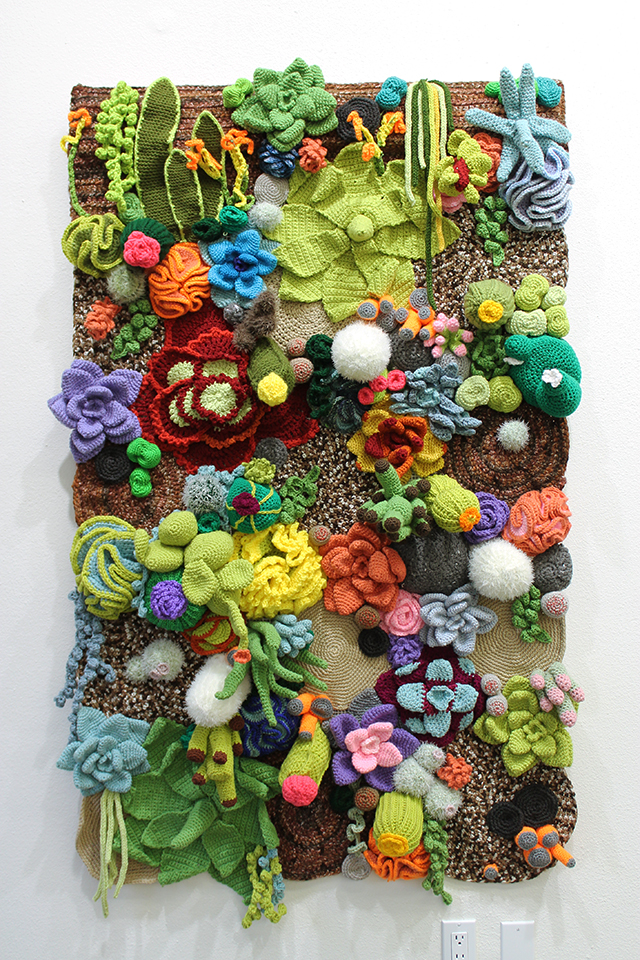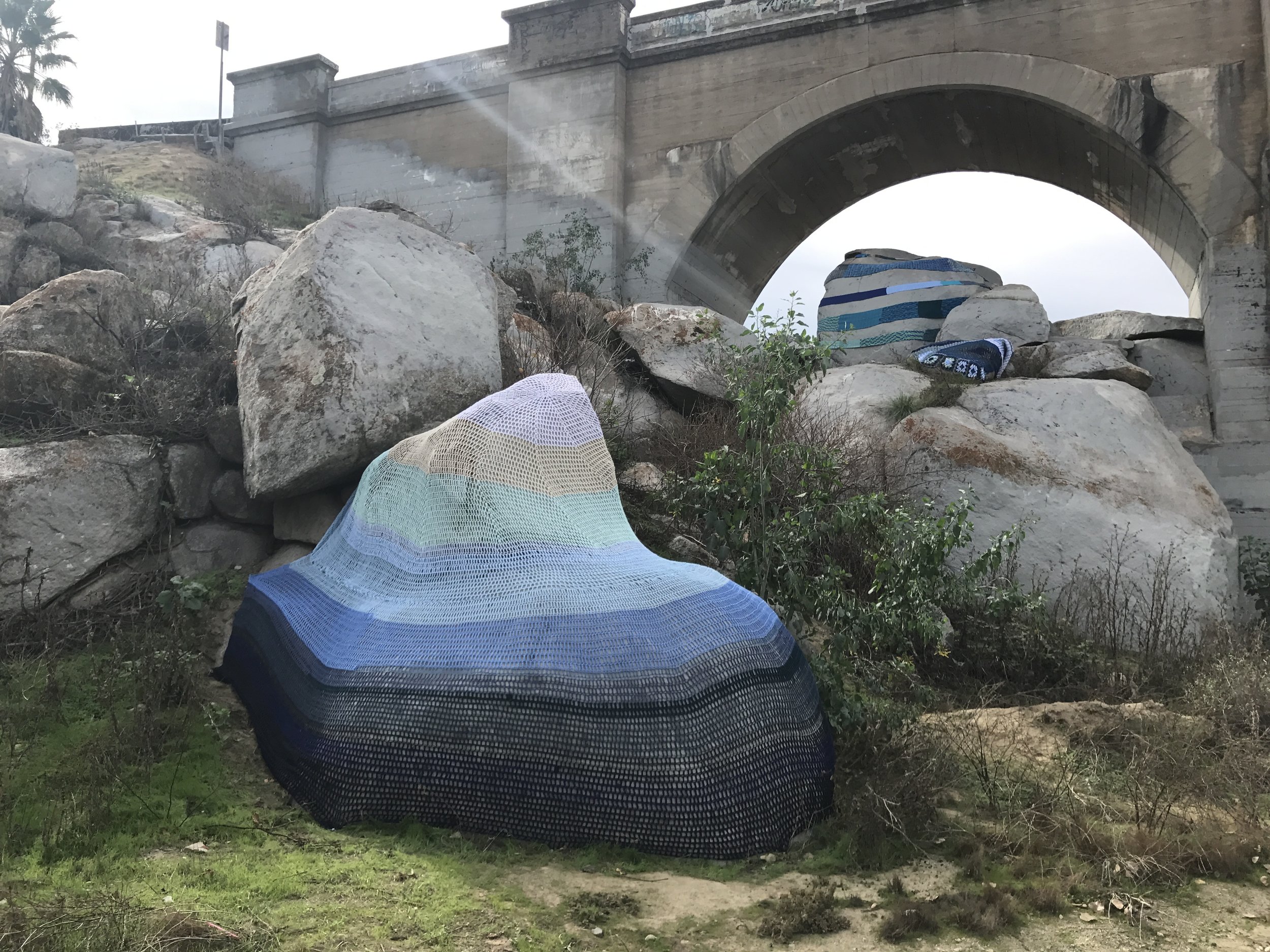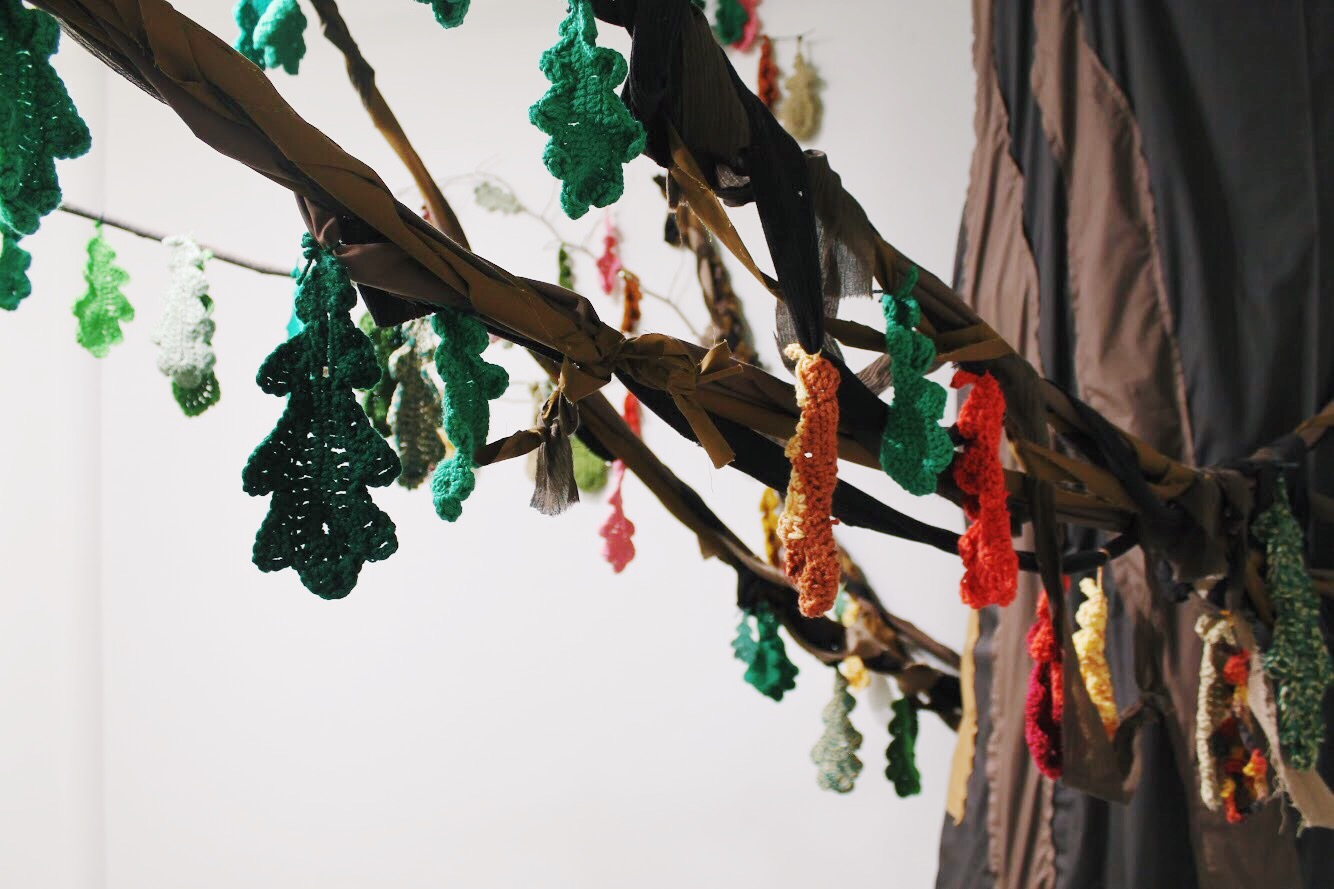Threadwinners is the moniker for the crochet collaborative comprised of Liz Flynn and Alyssa Arney. They began working together in 2013 as interns at the Orange County Museum of Art (OCMA) and started making art as Threadwinners in 2016. Flynn has an Art History BA from University of California, Riverside and works in LA. Arney has a Printmaking BFA from the John Herron School of Art and Design-IUPUI and works in Orange County.
Threadwinners, a play on the concept of the typically masculine term “breadwinner,” aim to subvert the patriarchy and status quo through the vehicle of crochet. They examine American and pop culture, the body, psychology, nature, gender roles, and femininity in their work.

First, let’s get to know a bit about the two creative minds behind Threadwinners. Can you tell us a bit about your backgrounds as artists? What common creative ground do you two share that brought you together for collaboration?
A: I graduated with a printmaking BFA and art history minor from the John Herron School of Art and Design - IUPUI, Indianapolis, IN. I’m originally from Terre Haute, where there’s not a whole lot of culture or entertainment for adolescents, so I always loved reading and art class in school. All of the other kids and teachers supported my work and it was one of the only things I felt confidence in. Additionally, my parents were over-protective, and I had go to a babysitter until the age of 12. Creating art was a great distraction from dealing with the kids who were younger than me.
When I graduated from college, I was working at a few restaurants in Indiana, not really exhibiting my work and just trying to make ends meet. I re-met my high school sweetheart, after seven years apart, at a house party and we instantly fell in love again. We moved out to California, where I began to make some big life changes.
L: I attended the University of California, Riverside, where I studied art history and education, with an emphasis on special education and reading remediation. I don’t have any formal artistic training, but I’ve been creating things by hand since I was a young child. I would constantly create collages, scrapbooks, and paintings that would crowd my room with color. Making things by hand has always been a release for me, a way to express myself visually rather than verbally.
In terms of common creative ground, I think we share a love for outsider art, the bizarre, and the ridiculous. We met in 2013 when we were both interns at the Orange County Museum of Art in Newport Beach, CA and almost immediately began bonding over those things. Through the course of the internship, we discovered that we worked really well together in a collaborative environment and from there eventually developed our artistic partnership.

How did the crochet collaboration come about? What inspired you to start Threadwinners and create your own creative platform?
A: When I moved to California, I decided to try my hand at knitting for a side hobby. It had always intimidated me, and as a kid my mom tried teaching me crochet and other needlework forms, but I was never able to understand it. Finally, I just hopped onto YouTube and dove headfirst into it. After I picked up knitting, Liz and I were talking one day and she told me that she was learning how to crochet with her mother and suggested I try it too because it was easy. Again, I got onto YouTube and Ravelry, put my knitting needles in the closet, and became obsessed with crochet.
At the end of the internship, Liz and I were part of a team to organize a student night at the OCMA, where we learned we were able to work really well together. After the internship ended, I was independently curating with our friend Natalie Mik, who then became a curator of my solo show Pleasure Objects. I asked Liz if she wanted to be my assistant for the project, but because she was putting so much time and effort into the pieces, her role grew to a partnership, and from that exhibition, we became a team!
L: After the joy of seeing Pleasure Objects manifested and experienced by others, we knew we had a unique and special opportunity to work on an extended body of work, so we began thinking long-term in regards to what our partnership could become. We adopted Threadwinners as our moniker in November 2016 while we were working on There Is A River Here, a yarn bomb project conceptualized by curator Carolyn Schutten and the Riverside Art Museum. Monikers are commonly adopted by artists in the yarn bombing and fiber arts community, so we wanted to follow that tradition. The creative platform that Threadwinners provides us has largely been inspired and supported by the online and local maker and fiber art community. We have received so much generous support from other creatives since the very beginning of this endeavor, and that support has been so humbling and has inspired us to further explore and develop the methods and themes employed in our work.

How does Threadwinners aim to challenge and transform the traditionally feminine craft of crochet into a powerful fine art medium? What are some topics your work confronts?
A: Most needlework practices, until fairly recently within the art realm, have always been relegated to the “craft” world and not really recognized by the “fine art” crowd. And while Threadwinners would never look down on that label or would ever want to disassociate from that term, we also don’t want to be completely defined or limited to that. To say that something is a “craft” rather than “fine art” is a bifurcation arbitrarily created by and implemented by the patriarchal Western hegemony. It’s a term to subjugate and oppress women, and especially working women, from creating “serious art.” Just look at haute couture; men run that gamut, and while utilizing traditional embroidery, crochet, knitting, lacemaking, and sewing techniques, they are allowed the privilege to elevate themselves above fashion, into the high art world. We won’t recognize or abide by those terms, nor do we need their permission to be artists. As long as people are creating things and ideas and self-expressing in one way or another, it’s all art, and should be recognized as such.
Threadwinners will continue pushing the boundaries of the crochet practice to create fiber sculptures and installations. We want to show the art world that recognizing the potential of a medium, instead of making a snap judgement about where its place lies in society, has the capability to reach across multiple spectrums and intersections of race, gender, and class. We also utilize the platform of crochet to talk about darker themes, but in a “soft, accessible, and approachable” way. The inherent soft and fuzzy quality that yarn possesses allows our audience to directly interact with the art objects. They act as psuedo-stuffed plushies, or nexuses, that can be easily handled while having a dialogue about the art, and not getting too depressed or grossed out by the themes.
Now that I’ve gone off on my tirade about sexism in the artworld, you can see that topics we like to address within our works include the inequities that women face within the art community, gender roles, the body, psychology, nature, classism, racism, and politics.

Congratulations on your most recent exhibition Reveries at Branch Gallery in Inglewood, CA! Can you tell us a bit about the variety of work included in the show? Your intricate crochet pieces often include installation work, which can be found at Reveries. Can you tell us about these pieces as well as other site-specific installations you’ve done? What happens to the material after an installation is finished?
A: Thank you! It’s been half a year in the making and it feels so good to finally see our work installed in the gallery. Sometimes we don’t get to see the scope of our work until it’s all hung in the space, and it’s really monumental to see how much we’re able to create in such a short time span.
L: Thank you! Like Alyssa said, it’s been such a rewarding experience to see our mental images and ideas manifested on the walls of Branch Gallery. With this body of work, Alyssa and I wanted to explore the world of landscapes and our bodily relationships with such sensory environments. Whether it’s a mental landscape, a dreamscape, a natural environment, or a constructed space, each environment that we experience and interact with as humans elicits a mixture of feelings unique to each individual. As defined by Merriam-Webster, a reverie is a daydream or a state of being lost in one’s thoughts. Along with externally occurring landscapes, we wanted to explore internal dreamscapes, spaces where one can get lost and explore the inner workings of their mind and consciousness. Our seven wall tapestries and installation pieces included in this show explore the synthesis of, and tension between, manmade and natural environments, and how human emotions relate to and form them.
A: With these installations, as well as other ones we’ve done in the past, we tried to reuse and recycle where we could. We stuffed a lot of the pieces with plastic bags, made armatures out of reused chicken wire and cardboard boxes, and sourced some of the yarn from local yarn stores that were willing to donate to our exhibitions, as well as fiber and acetate from Trash for Teaching (T4T) in Gardena, CA.
Personally, for me, this was a cathartic endeavor, to heal from the past 8 months in politics and to create something beautiful in the ugliness of it all. Although it’s hard for us little people to do anything about what’s happening in Washington, we have taken a gentle stance of resistance by donating a portion of art sales to the Sierra Club - Angeles Chapter, which serves Los Angeles and Orange Counties here in California.
L: Along with smaller scale yarn bombs that we attach to publicly available “canvases,” like chain-link fences, we have done large-scale site-specific installations as well. One of our most recent installations was There Is A River Here, an environmental installation curated by Carolyn Schutten and the Riverside Art Museum, in which we covered about ten boulders with handmade needlework pieces sourced from the local community through workshops and donations. After an installation is finished, we try our best to reuse the materials in other pieces and installations. The waterfall in Chromatic Cascade, for example, is made from yarn used in our There Is A River Here project. Other pieces from that project were restitched into blankets and scarves and donated to a local Riverside charity. We’ve also unwound other pieces to reuse the yarn, or cut up elements to use as stuffing for our sculptures. Other than that, we have most of our pieces and installation elements in storage for now! We’re always looking for other galleries or nontraditional spaces to show our past installations.
A: Succulent and Florid Flora were sort of vanity pieces. We both simply wanted to create large scale flower and succulent beds because we both have never seen anything like that in the crochet or fiber world before. I am a dog walker on the side, so for me personally, I walk through these wealthy neighborhoods where people have the privilege to hire landscapers to come and create these beautiful succulent and cacti compositions. I think I wanted to capture the beauty that these blue-collar workers create juxtaposed with the dichotomy of the trends that the rich are able to afford, and how both parties are able to realize this garden vision together.
A: In referring to Chromatic Cascade, I like to think about the waterfall creating its own music as it splashes into the pool below. We had musician Eric Flynn create a soundscape for this exhibition, so it adds another immersive element by bringing in the auditory aspect.
A: Coral Confection obviously talks about coral bleaching, and we again utilized recycled materials to create this installation. We also used traditional clothing materials like buttons and pins to decorate the piece that relate back to the last definition in the description above.
A: Earth Tome references back to being able to explore sort of ickier themes without really having to get your hands dirty.
A: We outlined Liz’s body to create the piece Verdant Quietus, and we’ve nicknamed her Ms. Skully Moss. We try to infuse a lot of humor into our work, even when we are talking about very serious themes. Laughter is a coping mechanism after all!

What is it about crochet that has captured your heart—enough to create a body of work exclusively based on this technique?
L: For me, the tactility of crochet is really appealing. There are so many different types of yarn you can use to explore texture and color. I’m a workaholic, so being able to keep my hands employed while talking, listening to podcasts, or watching TV makes me feel more productive. The repetitive nature of crochet is also very calming and therapeutic, which is what drew me into this practice to begin with.
A: It’s fun, easy, and you create so much work in so little time. I remember when I was knitting that it would take forever to finish a project, but you can easily make a hat or a scarf with crochet in an hour or two. Also, changing colors and creating three-dimensional shapes are a lot easier for me to conceptualize in crochet versus knitting.
Do either of you create artwork in any other mediums?
L: I personally do not. As of right now, I am juggling artistic production while working full-time, so I’ve found the most creative success channeling my extra energy into working with yarn.
A: My primary focus is the output from Threadwinners, but I do have an Etsy shop that I run that makes more affordable jewelry, prints, and functional art for the public.
What is something you’ve learned about yourself as an artist by working as a collaboration?
L: I’m very introverted, and throughout my school career I always preferred working in solitude. Group projects were the worst. I never thought I’d flourish in a collaborative work environment. However, working with Alyssa has shown me that I do, in fact, work better on a team. My ideas and methods are better defined when I’m able to bounce them off of Alyssa, and she will improve my concepts and take them to the next level. I hope I do the same for her! I still need time and space to go off and think by myself or create small independent projects, but overall my work is stronger and my mindset is healthier because we work as a team. Being one half of Threadwinners has shown me that I can be open to improvisation, collaboration, and letting go of some control (because I can be a neurotic control-freak at times).
A: I’ve learned that I have to be friends with the people I work with in order to create. If I’m not enjoying your company, then I won’t be in a good mindset to make the work too. I try to infuse a lot of humor into our interactions, and I don’t want what we do to feel like work. I want it to feel like we are hanging out, venting about politics, sharing, etc. AND that we are making something cool at the same time. I’ve also learned to listen better and compromise, because it’s not just my vision, it’s our vision as a team. People have said before that our work looks like it was made by one person, and that’s because Liz and I are constantly talking about how we each want the artwork to manifest itself, and we both get to arrange and make alterations to the work. Crochet and sculpture are forgiving in that sense.
What would you like to see for Threadwinners in the future?
L: We have so many ideas! We would like to create another Pleasure Objects show that explores sexuality and gender in the near future. Personally, I would love to create works that explore and discuss themes concerning space, time, and infinity. We would also love to contribute to and grow the local fiber art communities in the areas we live through collaborative projects, crochet circles, and educational workshops. On a more holistic scale, we want Threadwinners to subvert and change perceptions of crochet as simply novel crafts that belong in the home. People have been creating highly-skilled works of fiber art for centuries and were never given proper recognition, simply because the majority of them were women or female-identifying individuals. Through our work, we hope to pay homage to these unnamed and unrecorded fiber artist that have been lost to history.
A: Exactly what Liz said. She’s so smart, I just love her!



.jpg)









